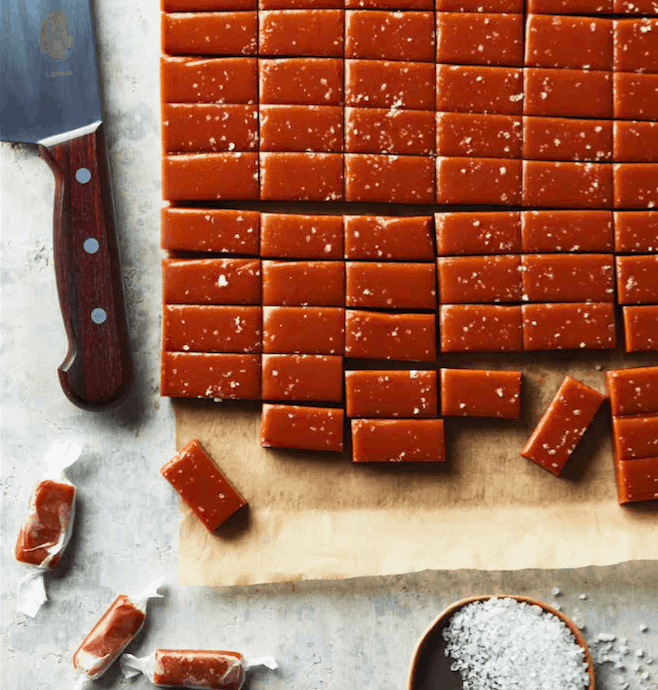IT’S EASY TO END UP IN THE BEST RESTAURANT IN VIENNA when everyone tells you to go to the same place. Steirereck ranks high on many global lists, celebrated for its contemporary Austrian cuisine, made with seasonal ingredients, and designed to celebrate regional dishes and the wines made to go with them.
But I wasn’t prepared to reach a gleaming modern glass and metal set of cubes as I reached the end of a leisurely stroll through bucolic Stadtpark. My lunch begins with a soup that glistens amber and red — a riff on solyanka, a peasant “kitchen-sink” affair expressed here as a sweet-and-sour pikefish consommé garnished with winter carrot. It’s so pretty I barely notice as the bread cart rolls silently by, captained by Andy Djordjevic, a.k.a. Brot-Andi, “the bread man.” His daily trolley carries 20 varieties, drawing from an index of more than 50 loaves supplied by nine Viennese bakeries.
Each item in my three-hour lunch is captioned Bob Dylan–style by little tabletop cards. They tell tales of seasonal and heritage ingredients, Austrian culinary history, and the philosophy of Steirereck’s owners, Birgit and Heinz Reitbauer. Birgit commands the front of house and Heinz operates the kitchen. His parents opened the original Steirereck in 1970. In 1992, the family acquired an inn about 90 minutes from Vienna. Today, Heinz’s parents run the Pogusch Country Inn, in Styria, its farm supplying both locations.
Lunch at Steirereck is delightful. Servers know the script but never seem scripted. There is stifled laughter and low-tuned conversation, which tends to hush when anyone is served the “char with beeswax, yellow carrot, pollen, and sour cream.” The star dish of Steirereck is introduced to the diner as a beautiful raw fillet, then taken away. It returns in a wooden frame into which the server pours hot beeswax. This is left on the table to solidify, the liquid slowly turning opaque. The server peels a corner of the wax to reveal the fish. It is removed from the table, returning on a white plate, accented in basil cress, and sided with a medallion of jellied yellow carrot and apple juice infused with beeswax. Under it, a pillow of sour cream with cayenne pepper and lime. Beside it, char caviar and quince vinegar “pollen.” These look like blackberries, but yellow.
Stunning — a dish that deserves contemplation. The windows of the restaurant are open. The scents and sounds of the sur- rounding parkland — trees in early leaf, flowers in early bloom, bees making busy work, kids at play — mingle with the magic happening at the table. It is May, outside and in.
Two hours to go. Next arrives a dish of green asparagus baked in salt dough and then charcoal grilled, with poppy seed miso hollandaise and lamb’s lettuce. Then, sturgeon, grilled and glazed with gin-infused cornel cherries, which have an astringent and acidic sour-cherry-meets-cranberry presence. A side of steamed Romanesco and roasted cauliflower is accented by the earthy leaves of pericon, a type of marigold, and apple. The final savoury dish: roast roebuck and braised veal tongue, with venison cream sauce, sided by turnip in goutweed spinach cream.
Every dish at Steirereck impresses. The wines too. Though wine director René Antrag is not present, his stewards elevate every dish with Austrian wines old, new, fresh, orange and unusual. There are no missteps. A 2019 Geyer Hof Kremstal Grüner Veltliner seems the only appropriate accompaniment to a braised young fennel with bergamot, hemp, salty figs and lovage.
Desserts are endless. The highlight: an ode to violets and medlar — and their opposing seasons. “Violets are among the first flowers to bloom in spring,” my card informs. Medlar is rarely used, I read, its fruit requiring tempering by frost to make it edible. These fruits star in a crispy fried crepe with fruit jam accompanied by petals of violet, lemon verbena and strawberry mint marinated in fruit juice, and ice cream flavoured with medlar kernel and violet. The earthy apple-sauce notes of winter-kissed medlar are harmonized by the bright floral and sweet spice notes of spring violet.
I sit for a few minutes, nothing more to read, and ponder the word seasonal. A word that, I had thought, had lost much of its meaning in contemporary cuisine. Not at Steirereck.
By Dick Snyder




